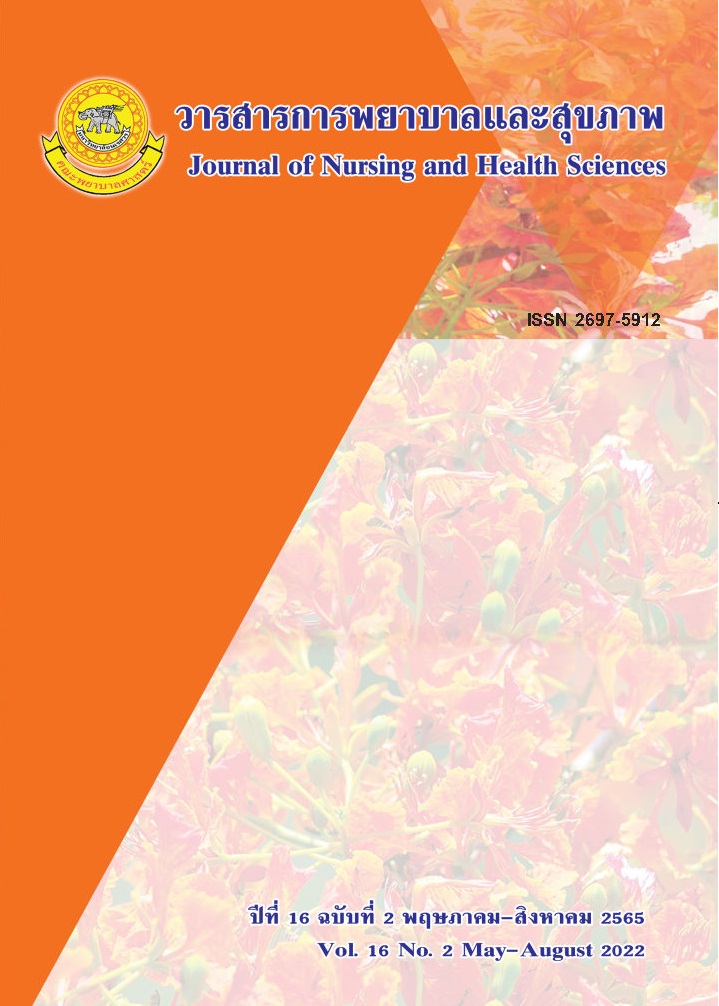Predictors of the Moral Behavior among Early Adolescents
Main Article Content
Abstract
Addressing moral characteristics and various factors affecting the inculcation of moral behavior in
early adolescents is significant. This study aimed to examine the predictors of moral behavior among early
adolescents. 121 participants were recruited using stratified random sampling from junior high school students
in extended opportunity schools in Chonburi province. The research instrument was aself-administered
questionnaire which consisted of 1) Demographic data, 2) Self-esteem, 3) Parenting styles, 4) Game addiction
screening test, and 5) Moral behavior. The Cronbach's alpha reliabilities were 0.91, 0.85, 0.88 and 0.91
respectively. Descriptive statistics and stepwise multiple regression were used for data analysis.
The results revealed that the mean score of moral behavior was at a moderate level ( = 3.36, SD = 0.63).
Predictors were authoritative parenting style, self-esteem and internet gaming addiction, which together
accounted for 40.1 % of the variance in moral character (p < 0.001). The strongest predictor was authoritative
parenting style (β = 2.308, p < 0.001), followed by self-esteem (β = 0.975, p = 0.010) and internet gaming
addiction (β = - 0.321, p = 0.016).
These findings suggest that the tailored intervention program should be emphasized by promoting an
authoritative parenting style and self-esteem, and ways to preventinternet gaming addiction to cultivate better
moral behavior in early adolescents.
Article Details

This work is licensed under a Creative Commons Attribution-NonCommercial-NoDerivatives 4.0 International License.
References
Aroonjit, N., & Ganthong, S. (2015). Parenting behavior
and emotional intelligence of students. Naradhiwas:
Princess of Naradhiwas University. [In Thai].
Bandura, A. (1986). Social foundations of thought and
action: A social cognitive theory. Englewood
Cliffs, NJ: Prentice-Hall.
Baumrind, D. (1971). Current patterns of parental
authority. Richmond,Va: American Psychological
Assn.
Boonyaprakob, V. (2014). The development of child and
adolescent moral and ethics. Retrieved 7 June
from: https://facebook.com/jubjitTU/posts/
[In Thai].
Cohen, T .R., & Morse, L. (2014). Moral character: What
it is and what it does. Research in Organization
Behavior,34, 43-61. doi: 10.1016/j.riob.2014.08.
Dasri, S. (2012). Causes of Aggressive Behaviors of
the Students in the Educational Opportunity
Extension Schools under Buriram Educational
Service Area Office 2. Master of Education
(Educational Administration), Buriram Rajabhat
University,Buriram. [In Thai].
Fatima, S., Dawood, S., & Munir, M. (2020). Parenting
styles, moral identity and prosocial
behaviors in adolescents. Current psychology, 41(1),
-910. doi:10.1007/s12144-020-00609-3.
Funder, D.C, & Fast, L.A. (2010). Personality in social
psychology. In S.T. Fiske, D.T. Gilbert & G.
Lindzey (Eds.), Handbook of Social Psychology
(pp. 668-697). John Wiley& Sons, Inc. doi: 10.
/9780470561119.socpsy001018.
Juntipwaree, J., Hongchayangkool, K., & Watthanasit,
P.(2015). Relationships between moral
development, moral behavior and aggressive behavior of
students in junior high school. Songklanagarind
Journal of Nursing,35, 60-76. [In Thai].
Heng, C. J., & Rabbani, M. (2020). The Relationship
between Gaming Addiction, Aggressive Behavior
and Narcissistic Personality Traits among
University Students in Malaysia. Indian Journal
of Public Health research & Development, 11(5),
-624.doi: 10.37506/ijphrd.v11i5.9401.
Cash, H., Rae, C.D., Steel, A. H., & Winkler, A. (2012).
Internet addiction: ABrief Summary of Research
and Practice. Current Psychiatry Reviews, 8(4),
-298. doi: 10.2174/157340012803520513.
Kim, E. J., Namkoong, K., Ku, T., & Kim, S.J.(2008).
The relationship between online game addiction
and aggression, self-control and narcissistic
personality traits. Eur Psychiatry, 23(3), 212-218.
doi:10.1016/j.eurpsy.2007.10.010.
Klaykaew, K.K. (2014). The Role of Families in the
fostering and development of children becoming
good citizens in a democratic society. Journal of
Behavioral Science, 20(1), 1-18. [In Thai].
Kohlberg, L. (1964). Development of Moral Character
and Moral Ideology. In M. L. Hoffman & L. W.
Hoffman (Eds), Review of Child Development
Research. New York: Russell Sage Foundation.
Lee, C. S., & Jang, H. Y. (2018). Moderating Effect
of Empathy on the Relationship between
Self-esteem and Aggression of Adolescents.
Journal of Digital Convergence, 16(1), 47-53.
doi: 10.14400/JDC.2018.16.1047.
Igba, I. D., Oka, O. I., & Chidimma, I.I. (2016). Factors
Affecting the Inculcation of Moral Behaviour
in Youths within Families in Ohaozara Local
Government Area Ebonyi State. British Journal
of Education, 4(6), 29-43.
Pornnoppadol, C., Sornpaisarn, B., Khamklieng, K.,&
Pattana-amorn, S. (2014). The
development of game addiction screening test (GAST).
Journal of the Psychiatric Association of
Thailand, 59(1), 3-14. [In Thai].
Steinberg, L. (2017). Adolescence (11st ed.). New York:
McGraw-Hill Education.
Tabachnick, B. G., & Fidell, L.S. (2013). Using
Multivariate Statistics (6th ed.). Boston: Pearson.
Wonginjun, S., Chaisena-Dallas, J., Kwansumran, W.,
& Aunkaprasatchai, W. (2021). Relation between
selected variables and the moral characteristics
among junior high school students in extened
opportunity schools. Nursing Journal of the
Ministry of Public Health, 31(1), 58-69. [In Thai].
Wongpakaran, T., & Wongpakaran, N. (2011). Confirmatory factor analysis of Rosenberg self-esteem
scale: A study of Thai sample. Journal of the
Psychiatrist Association of Thailand, 56(1),
-70.
Vorasiriamorn, Y., Rittirong, J., Chuanwan, S., &
Hunchangsith, P (Eds). (2014). Population And
society 2014: birth and security in population
and society. Nakhon Pathom: Institute for
Population and Social Research, Mahidol
University. [in Thai].
Zhou, Z., Shek, D. T .L., Zhu, X., & Lin, L.(2021).
The Influence of Moral Character Attributes
on Adolescent Life Satisfaction: the Mediating
Role of Responsible Behavior. Child Ind res, 14,
-1313. doi: 10.1007/s12187-020-0979


